A Warming Planet in Revolt, and a Collage for LMAC #89
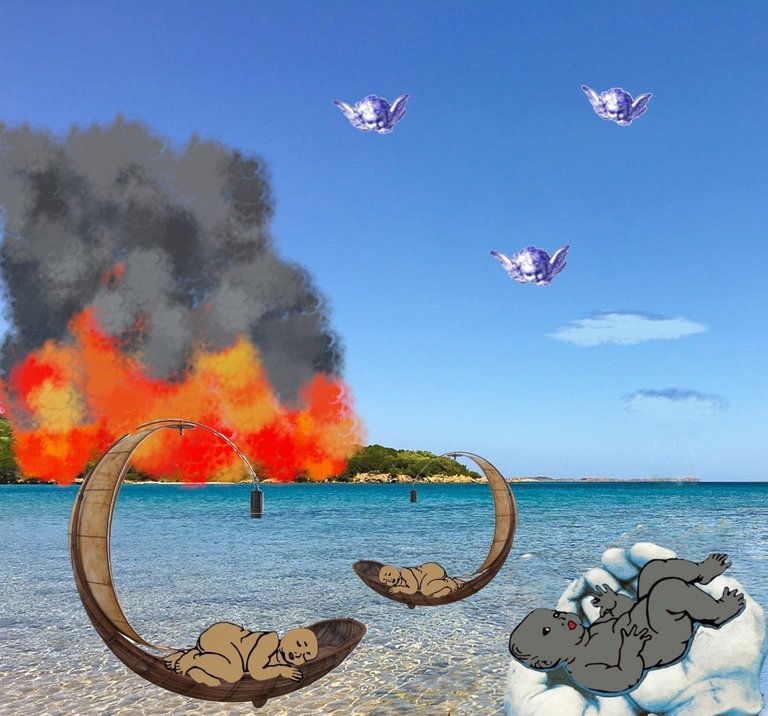
As I wake up this morning I read about catastrophic flooding in Germany, Belgium, Luxembourg and the Netherlands. I read about fires of biblical dimension raging in the western part of the United States. Is nature conspiring against us, or are we conspiring against ourselves?
My collage this week was no doubt inspired by natural disasters. When I saw @shaka's serene template photo, I imagined the beautiful island consumed by fire.
The Template Photo by @shaka:
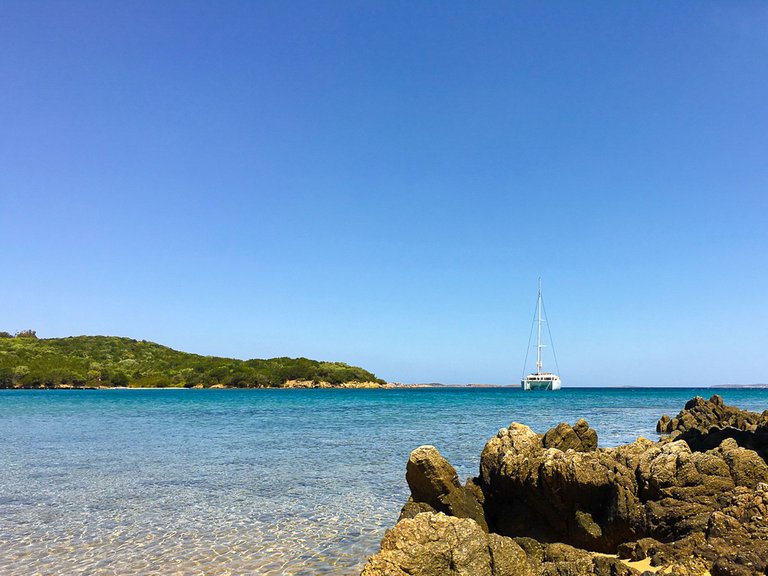
Then I imagined all the rescue workers who sacrifice themselves to save life--our angels on earth. So in my grim image of cataclysmic fire, I offer the possibility of divine intervention, the saving of the innocent. We cannot hope on earth for such intervention, though. We must be our own angels. We must save ourselves, as much as possible, from a future of fire and flood.
While the cause of extreme weather conditions may be argued by some, there can be no doubt that human activity contributes to the disastrous turn of nature.
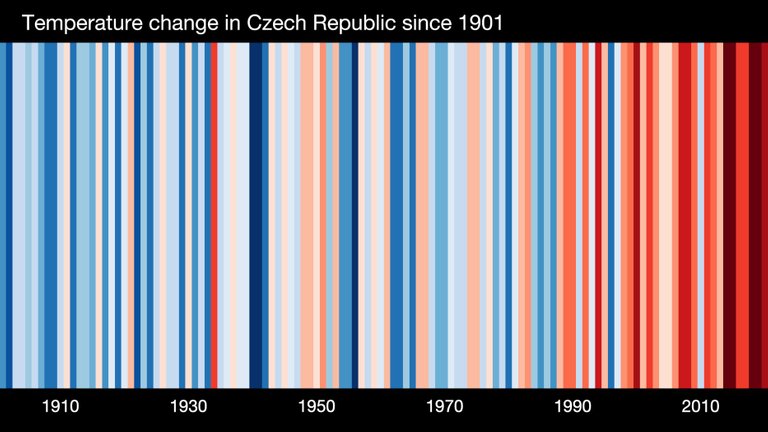
Image credit: Professor Ed Hawkins, University of Reading. Used under CC 4.0 license. The text under the graphic reads: " These ‘warming stripe’ graphic from ShowYourStripes.info is visual representations of the change in temperature as measured in Czech Republic over the past 100+ years. Each stripe represents the temperature averaged over a year."
Human Activity and Climate Change
It used to be argued by some that the earth's climate was not warming. As irrefutable evidence of an increasingly warmer earth mounts, the argument has changed. Now many who oppose environmental reform suggest climate change is little affected by human activity. Or, this faction against reform suggests, such action will be too costly. Let's look at these arguments.
63 Years of Climate Change, 1950-2013
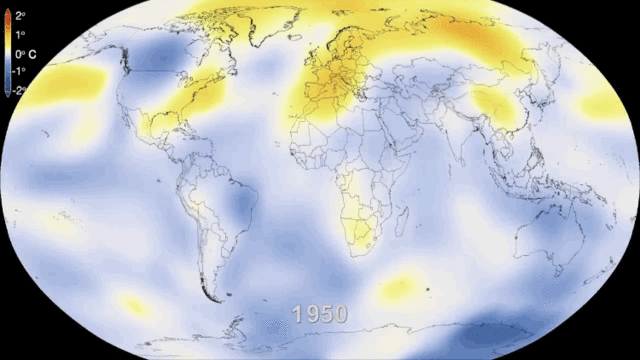
Image credit: NASA. Public domain.
Those who argue against taking action claim that climate change has a long history, and temperatures on earth have fluctuated over its long history. However, it is precisely by studying these periods of change that scientists have discovered the role carbon dioxide plays in the earth's climate. Overwhelmingly, it is the burning of fossil fuels that releases the greatest amount of carbon dioxide into the earth's atmosphere.
Difference From Historic Average Temperature Since Last Ice Age
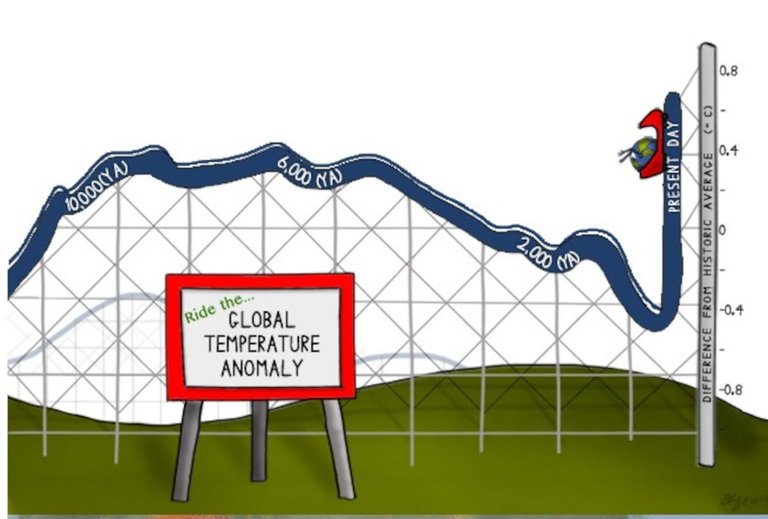
Image credit: Emily Greenhalgh for NOAA Climate.gov. Public domain, with attribution.
The text accompanying this graph states: ...the last decade has brought global average temperatures higher than they have been for at least 75 percent of the last 11,300 years. And, the text continues, recent increase has been...so abrupt compared to the rest of the time period that when the scientists make a graph of the data, the end of the line is nearly vertical.
In other words, the rapid rise in temperature over the past century is unprecedented in earth's history. (Information derived from What’s the Hottest Earth Has Been “Lately”? on climate.gov)
Effect of Climate Conditions on Farm Business, 2000-2019, Australia
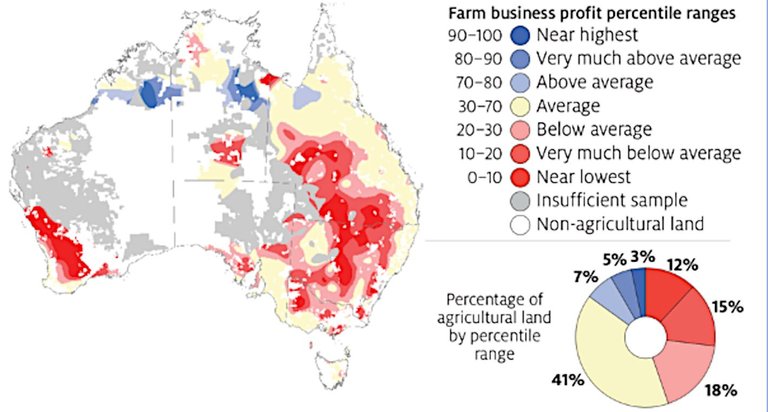
Image credit: Australian Bureau of Agricultural and Resource Economics and Sciences. Used under CC 4.0. license.
In 2019 the Brookings Institute issued a report, Ten Facts About the Economics of Climate Change and Climate Policy. The Institute found that the damage to the U. S. economy will accelerate with every degree of warming. The effects will be spread across many sectors. Affected will be: "agricultural productivity, mortality, crime, energy use, storm activity, and coastal inundation." In the words of Brookings, the changes will be 'nonlinear'.
Colorado River
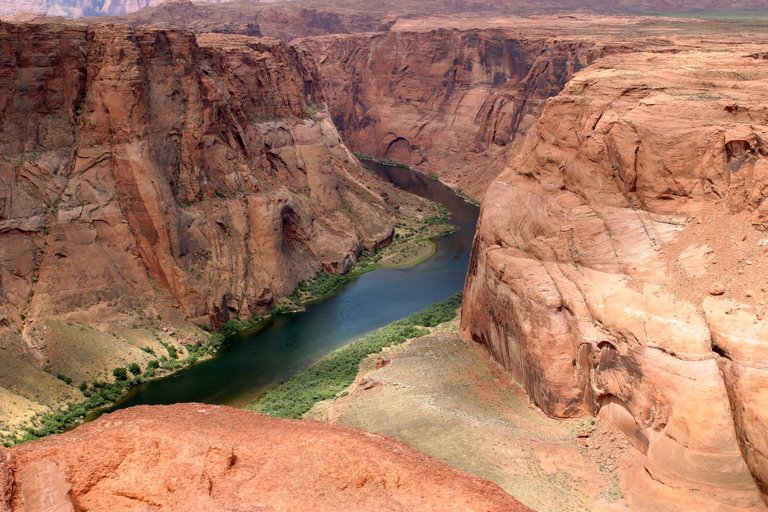
Image credit: Adrille (edit by Aqwis). Used under CC 3.0 license. According to the webside AZcentral, multiple factors are affecting the health of the Colorado River, which provides water to several states through the Southwest (USA). Reduction in snow cap melt, fires, and the eroding flow of tributary streams are among the conditions that are decreasing water volume in the Colorado.
The Brookings Institute estimates economic losses in U. S GDP, and in per capita income will depend on the amount and rate at which global temperatures rise. If, by 2099 the increase is as much as 4 degrees Celsius, GDP loss will be around 2%, annually. These losses will be the effect of, "rising mortality as well as changes in labor supply, energy demand, and agricultural production."

The few aspects of climate change I have addressed here don't even scratch the surface that the impact a warming earth will have on life. The implications go beyond these few examples. There are novel diseases that will certainly appear (because of a change in proximity to wildlife, for example). There is social and civil unrest, competition between nations for scarce resources that will contribute to war, and mortality/death from a decline in air quality.

My Collage
I knew what I wanted to do from the start. The cupping hands and the baby were the beginning. And I knew I wanted angels watching over the baby. I'll admit I'm not satisfied, but I spent a lot of time on this and have to recognize when that is just getting obsessive.
After I found the hand sculpture (Antranjas on Pixabay), I looked for a baby (Prawny on Pixabay), extracted and colored the baby (hard!),desaturated @shaka's picture and then put the hands and the baby together. Resaturated @shaka's picture. Put the sculpture/baby back in @shaka's altered photo. Found some angels (GDJ on Pixabay,) separated the angel (hard!) and colored. Found another baby (Prawny on Pixabay,) separated and colored again. Found a boat (Jazella on Pixabay.) Put the baby in the boat, and then started to play around. (Bird accent in the blog is credited to almeidah on Pixabay)

Of course there were missteps. I couldn't find a fire so I made my own with a GIMP brush. Clouds I added also with GIMP brushes. I kept moving the babies around, adding filters,etc, but finally decided my plain picture was the best I could do.
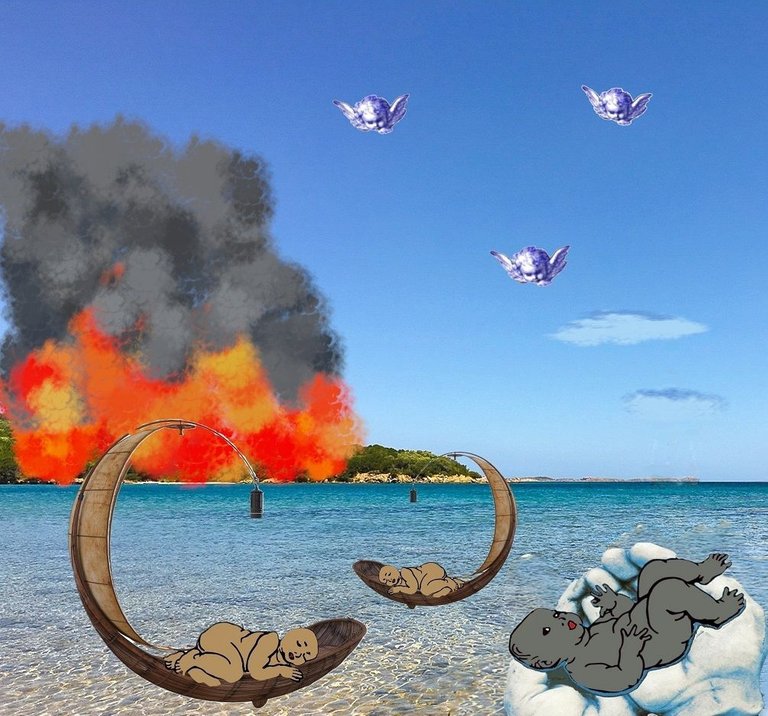

Thank you @shaka for another creative excursion. Readers can see these excursions take me onto unplanned paths. I don't enter the contest, but make a collage because I learn something every week. Plus, LMAC is a really nice place to hang out.
LMAC may be one of the most accessible communities on Hive. Anyone can join, and anyone can manipulate a photo. The rules may be found on @shaka's blog. We have a school, a list of resources, Discord channel and a teacher, @quantumg, who answers questions with patience and grace. There is still time to enter this round, which doesn't end until Monday evening.
Please read this blog, LMAC School - Public Domain Picture sources (Free Materials for creating collages), written by @quantumg, which discusses public domain issues. The blog offers links to sources that offer public domain pictures. Using public domain pictures is an absolutely essential requirement for all collages submitted in the LMAC contest.



Hive on!
Un buen collage amigo, tristemente nosotros hemos contribuido a que ocurran todo estas catastrofes que hoy azotan la tierra, ojala tomemos un poco de conciencia y cuidemos nuestro medio ambiente!
Thank you @kismeri for your support and your kind words. Makes me very happy that you read my blog and appreciate my research. Have a great week my friend.
Gracias e igual que tengas una buena semana 🤗🤗
Living through exceptionally strange days, interesting collage with loads of links and interesting information.
Socio-Economic based violence is running rampant through our city today in KwaZulu-Natal with no end in sight as yet after a full week, yes this world has changed and humans along with it.
@tipu curate
Upvoted 👌 (Mana: 71/91) Liquid rewards.
I appreciate your support, very very much. I also appreciate the information about KwaZulu-Natal. I've done some research on the history of South Africa, plus I've read Coetzee, so I have a sense of what you are describing. It's amazing to me that people think they can wall off the effects of climate change. Or, for that matter, that people think they can wall off the effects of economic and social chaos. We all live on the same planet. We breathe the same air. Derive sustenance from the same ocean. So narrow to think we can insulate ourselves from each other.
Forgive me for going on. Something I (obviously) feel strongly about.
Thanks again for reading and appreciating my blog. Have a safe and productive week.
If people don't work together for change everyone will be affected, land, sea, air and yes among each other.
Too many instigate chaos, too few knuckle down to actually do something positive to make change happen.
Today is Nelson Mandela's birthday, each member of society requested to give 67 minutes helping others in any way they are able, a sobering thought after the last week.
https://invidious.xyz/watch?v=tul07hx8V8w&local=true&dark_mode=true&autoplay=0
Climate science you won't get from the corporate flashylight box.
Hi,
Thanks for stopping by. I don't click on links that are unfamiliar to me, so I can't appreciate your reference.Sorry...
https://github.com/iv-org/invidious
Invidious is an open source front end for utub.
If that is all it takes for them to keep the truth from you, I don't hold much hope for wherever you are.
I'm not tech savvy at all. Small fish in big waters.
Me and you both.
Blind leading the blind.
I found it through this privacy extension, also open source.
It was tedious to work with until I learned which instances were more reliable.
Thank you :) I usually check with my son when I'm hesitant. I paid for a lot of tech courses. Cashing in now :)) (He introduced me to the blockchain).
This is a very important topic you bring on here.
I‘ve studied climatology and never read of an increase of 4 degrees Celsius („by 2099 the increase is as much as 4 degrees Celsius,“). That would be really frightening.
The collage is great 👍
I really appreciate your stopping by. I claim no knowledge about climate science, which is why I refer to sources that are more informed. I especially chose the Brookings Institute for the economic assessment because they are 'establishment' oriented (one of the financial backers is Qatar!). I figure if they have something dire to say about the economic consequences of climate change, that is persuasive.
Thank you for liking my collage. It's not very arty, but it does convey the message. Frankly, I'm really, really afraid for the future. I can't see anywhere the will to turn the climate crisis around. And even with the will, is there time?
I don‘t see the will either and I expect no effective supranational agreements.
And even if there was the will, I think the delayed effect of greenhouse gases could make big damage in the long term.
But I expect technological progress and our capability to capture CO2 from the atmosphere within the next 50 years. And I hope and tend to think that that will be soon enough 🙏🏻
Thanks for that one ray of hope in our environmental Pandora's box.
My respects to you my friend, thank you for the information provided.You are absolutely right when you say that we should not wait on earth for a divine Intervention we should be our own angels.Only we can save ourselves from the damage we are doing to the planet as much of what is happening in our fault.Beautiful collage, the babies look peaceful curled up in the boat and the baby in the hand is wide awake watching everything. Cheers and have a good night😁.
I'm very happy you noticed the posture of the babies. Yes, I wanted to convey both those attitudes you mention. A baby alert and looking around, perhaps worried and the others unaware, innocent, dependent.
Thanks so much for visiting and reading my blog. I don't think the collage is artful. So many of the other collages I've looked at are just beautiful (including yours, which I have not commented on yet). But the message is carried strongly in my simple collage, and that I guess what I was aiming for.
Have a safe and healthy week
A wonderful timely collage A.G. Love the babies in the baskets and the angels.The hand holding the baby is a nice touch.💞
Climate change is having drastic effects and is something we must all be concerned about as you mentioned, we must help ourselves and not expect divine intervention.
I hope your summer is going well my dear A.G.
Thank you my friend @redheadpei.You are always kind.
I felt so bad after looking at pictures of the floods. The devastation. Lives lost. The collage was inevitable. A collage with hope. I'm glad you like the babies and angels. Bright spots in a dismal scene.
Thank you for the tip, the reblog and the visit. My summer is going well, thank you.
Peace and happy days to you and all your furry friends up North :)
Hello @agmoore. Yes, we are living through strange and unnerving times indeed. I too read about the devastating floods in those countries. Then I read about the drought and wildfires in the U.S. The world is turned upside down in the change of climate over the decades.
Your collage lovingly portrays what is happening. Opposite events from one end to the other. The baby cradled in the arms and those saved by the devastation presents the theory that there is hope. Even for those who deny a change has taken place.
Thanks so much for your thoughtful analysis of our current situation surrounding every country. We must all work together to save this planet because there is no Plan(et) B.
Appreciate you sharing this.
Thank you @justclickindiva. Thank you for seeing the hope. The babies are hope. And, "there is no Plan(et)B. You are so right.
The climate challenge is hard to think about, because it's such a serious situation, and the trouble is now, not in the future. But if we don't think about it, life is doomed as we know it.
The great thing about art (not that my collage is art) is that it expresses feeling without preaching. It's another language. I love using that language.
I'm grateful you visited and that you read my blog. I hope you and your family have peace and health in your lives. Enjoy the rest of the weekend.
Regards,
AG
The change in environment is becauae of humans only. What happened in European countries is very sad.
Best wishes for contest..
Thank you very much for visiting my blog and for your good wishes. I don't enter the contest because I am one of the jurors. It is so much fun to make a collage that I create one every week, anyway.
Have a peaceful day :)
It’s awful we saw the damage while travelling through holland to Germany
It was harsh
Creative Created Collage you made a new word
Well done , I hope this will enter you in the finals good luck this week
Britt
That must have been a grim part of your trip. I guess the kids got a lesson they will never forget.
Thank you for visiting my collage and for your kind words. I don't enter the contest anymore because I'm on the jury. That would be a conflict of interest.
Let's hope for sanity in the world community. Let's hope we protect our environment going forward.
Have a most peaceful day.
AG
That was all
Over the news and indeed a lesson learned because in Holland that doesn't happen much, last time was 48 years ago we a country with dikes and water management
Not good
😞
Hi @brittandjosie, I'm trying to reach the terminal to ask a technical question but I don't know how to get there. Could you please send me a link? thanks
https://discord.gg/3RgAUgEr
Got in already. Thank you!
Your content has been voted as a part of Encouragement program. Keep up the good work!
Use Ecency daily to boost your growth on platform!
Support Ecency
Vote for Proposal
Delegate HP and earn more
Thank you very much for the recognition and support.
Colorful and very creative collage. Wish you luck in the contest. 😎
Thank you, @seckorama. I enjoyed making the collage, though the subject (catastrophic climate change) was sobering.
I don't enter the contest anymore because I'm on the jury. That would be a conflict of interest :)
Ok. I don't know you're the judge in LMAC contests.
Anyway, your collage caught my attention so I commented it 😎
I'm so happy you like my collage. It wasn't as pretty as I hoped it would be. So many are beautiful.
Congratulations @agmoore! You have completed the following achievement on the Hive blockchain and have been rewarded with new badge(s) :
Your next target is to reach 7750 replies.
You can view your badges on your board and compare yourself to others in the Ranking
If you no longer want to receive notifications, reply to this comment with the word
STOPThank you for the notice. That is a lot of engagement, isn't it ? 😄
Yes it is @agmoore 😊👍 So keep going with this nice energy!
Hi, I love babies and angels.
And fire was very nice for you
Thank you, @eve66. I love the babies and angels, also. It's my universe (my collage), so I had to put some hope in there.
Have a great week!
Hello @agmoore,
I have seen the terrible photos and countless videos of the flood disasters and I am also deeply shocked.
Shocked by all the dead, the destruction, but recently also by the catastrophic failure of the authorities in my country to have warned people sufficiently, even though there were indications of an impending disaster.
Me and my family have donated for the reconstruction of the affected areas and houses and we are currently looking for more ways to help. Some neighbours and other people I know even had the opportunity to go to the disaster areas to help the people there with their own hands.
There is a lot of solidarity and this is the brightest light in these dark days.
Your collages always tell stories or are a supporting part of your education/art composition. From my point of view, that is very well done again this time.
I also like the idea behind it, it's highly creative!
I feel your anger. Me too. I kept asking my husband why there was no notice. We have so much advanced technology, how could the floods have been such a surprise. Horrible.
In the end, it always comes down to the individual. We can't look to our left or to our right. We can't look to a bureaucracy. We have to do it ourselves. I'm not surprised that you are helping out.
Yes, my collage is expressive, but not very esthetically pleasing. Thank you for reading and for your kind assessment. You know my thoughts are with those who are suffering from the disaster.
Hello friend, again an excellent collage with a message that leads us to reflect with all the damage that we ourselves give to our planet is a global problem that affects the entire planet.
Thank you for reading my blog and for your kind words. Yes, the catastrophic effects of climate change are all around us. Nobody escapes this.
Stay peaceful, and well, my friend.
A virtual hug friend.
🌷🌸🌹
😇